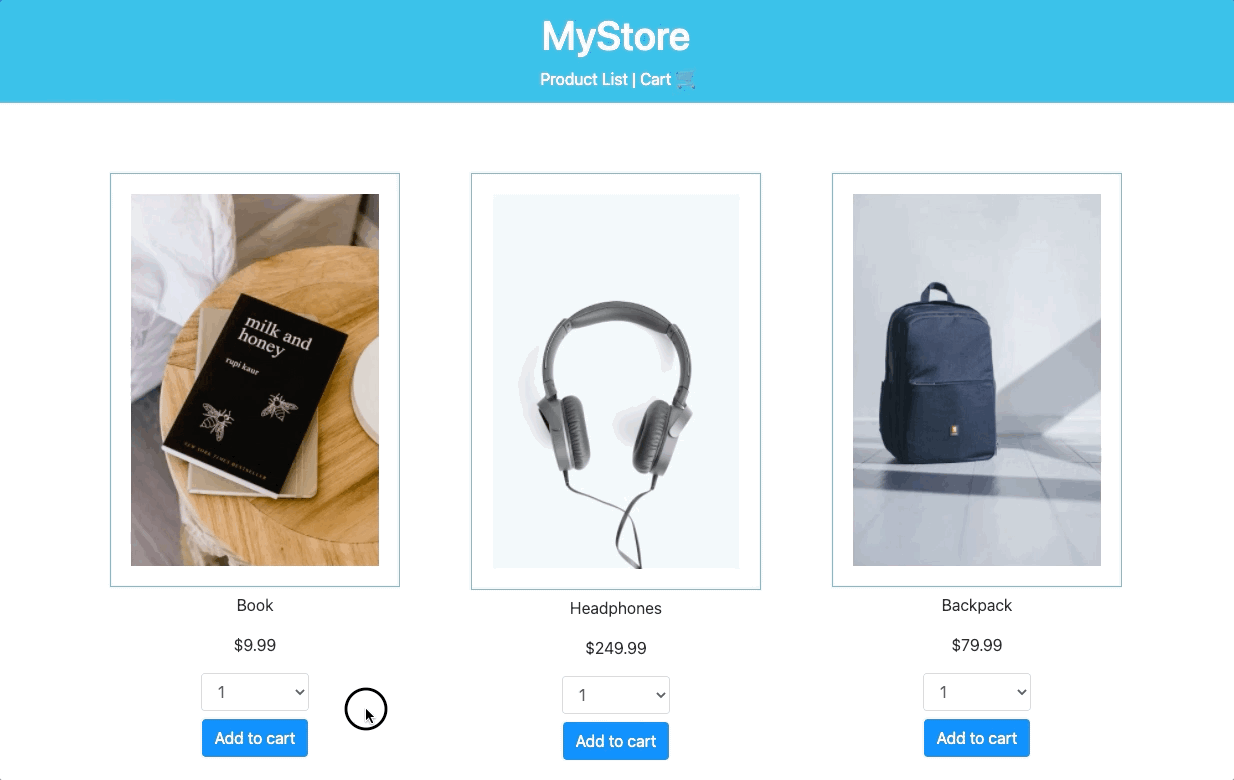MyStore is Angular application that allows users to view a list of available products to purchase, add them to a shopping cart, and ultimately complete the checkout process.
To use these files, simply merge the folders into the root directory of your scaffolded Angular application.
to install packages type yarn
to start type yarn start
to bulid type yarn build
You've completed the course! You know how to create a single-page application to offer a rich, dynamic experience on the web.
To showcase your new skills, you'll build an e-commerce website – an application that allows users to view a list of available products to purchase, add them to a shopping cart, and ultimately complete the checkout process.
Many applications that you use daily include the functionality to read, write, update, and delete content provided by APIs. For example, a typical image-sharing social media application may allow you to view photos, add photos, edit them, and remove them from an album or user account. Similar to such applications, this project relies on input from users of the application. After completing this project, you'll solidify your skills in designing and creating interactive CRUD applications in the real world.
Throughout the course, you've learned a lot about Angular components, services, modules, services, routing, and data flow. Before you begin scaffolding the application, ask yourself:
- How do I fetch and use data from an external API (or JSON data file)?
- What does a logical hierarchy of components look like? For example, which components should be parent components, and which components should be their children components?
- How do I collect input from the user, using controlled form elements as the "source of truth" of such data?
- What are events in Angular, and how do I listen and respond to them?
- What is a model, and how do I create one in TypeScript?
- How do I pass data between parent and child components? Hint: Which decorators should be used?
- How do I pass data between sibling or otherwise "unrelated" components?
- How is routing set up in the templates? Likewise, how do I configure the app routing module to support this?
The Angular CLI allows you to quickly scaffold a new application, as well as generate all necessary components, services, and modules. While you'll use the CLI to create a new application from scratch, we've provided some code and data to help you along the way:
-
CSS. The provided stylesheets are not required, but you may use the included CSS classes to help you style the application. Feel free to use your creativity and build a UI as you see fit!
-
data.json. You may fetch the list of products for your store from the API created in the previous course of this Nanodegree program. In lieu of using that data, you may also choose to have your application read the provideddata.jsonfile to populate your store.
If you choose to use the starter code, all files can be downloaded here. To use them, just merge the folders into the root directory of your scaffolded application.
Your application reflects the same user experience as that of a real-world e-commerce website, including a(n):
- Product list page, which displays the available products for the user to choose and add to their cart (in various quantities)
- Product details page, which displays more information about any particular product
- Shopping cart, which includes the products that the user has added to their cart
- Checkout form, which collects information about the user (e.g., name, address, payment details, etc.)
- Order confirmation page, which shows the outcome after the user completes the checkout process (i.e., submits the checkout form)
Feel free to use this overview and the rubric specifications to create this project. You are always welcome to design and implement your own workflow, but if you are stuck or could use some inspiration, we've included the following walkthrough the help you get up and running.
- Scaffold your project using the Angular CLI, and install any dependencies.
- Generate the product list component. Having the product list as the "main" page is a great start for your users.
- Begin building the component logic and template What is the function of the product list? What logic is included in the TypeScript component, and how does its HTML template function? Does this component collect any user input? If so, how does information entered by the user relate to properties in the TypeScript component?
- Consider the hierarchy of components. Which other components do you anticipate you'll need to build in this application? Which component(s) should render other components? Which components should represent a parent-child relationship? Feel free to draw out this hierarchy as a chart to help you visualize the relationships between components.
- Create the TypeScript model for products in the app. Any available product should be of this type, rather than an ordinary object.
- Generate the service(s). Which service(s) make the most sense? For any particular service, what is its function? Hint: You may want to create a service to handle any asynchronous data.
- Fetch data from the API (or included
data.jsonfile) and render products in your product list. - Generate and create other components. How do these components interact, if at all, with the component you first created? How can we facilitate sharing information between them?
- Create routing between components. Which components are linked by the router? How is the app routing module set up and configured to make sure the page doesn't reload during navigation?
- Ensure that inputs are validated in the client. For example, your checkout form needs to collect information from the user in order for them to complete the checkout process. How do you ensure that you are collecting accurate information from the user?
